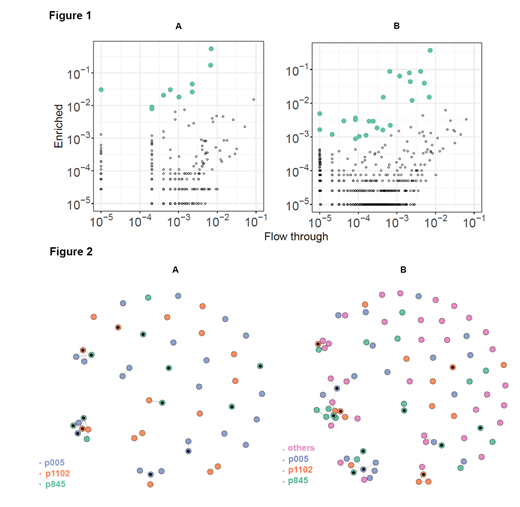Allogeneic hematopoietic stem cell transplantation (allo-HSCT) is currently the only curative therapy for hematological malignancies yet in nearly one-third of patients, it is followed by a relapse of the disease contributing to high mortality. In fully HLA-matched allo-HSCT graft versus leukemia reaction is driven by the recognition of the minor histocompatibility antigens (MiHAs) - endogenous polymorphic peptides presented by MHC. Particularly, HA-1 MiHA is a promising target for immunotherapy. HA-1 is presented by frequent among Caucasians HLA allele - A*02:01. The single nucleotide variation in ARGHAP45 gene which generates the MiHA has the optimal allelic distribution, thus immunogenic mismatch occurs in 30% of allo-HSCT. Also, ARGHAP45 is overexpressed in certain types of leukemia. Here we aim to develop HA-1-specific T-cells for post-transplant relapse therapy.
To obtain the sequences of HA-1-specific T-cell receptors (TCRs), naive CD8+ T-cells from 3 HLA-A*02:01 positive and HA-1 negative donors were expanded in vitro using autologous dendritic cells pulsed with HA-1 peptide. Antigen-specific cells were enriched by CD137 marker expression or by HLA-tetramer staining, RNA from positive and negative fractions was isolated for cDNA library preparation. The α and β TCR-repertoires were sequenced using the Illumina MiSeq system. The representative enrichment plot is shown in Figure 1 (A - α chains, B - β chains). Each circle represents a unique TCR. The vertical axis shows the normalized frequency in enriched fraction, the horizontal axis shows the normalized frequency in tetramer or CD137 negative flowthrough. HA-1-specific TCRs are denoted by green filled circles.TCRs were considered to be HA-1-specific if they were significantly enriched in CD137+ or tetramer+ fraction (exact Fisher test, p=0.05). In total, 49 α and 80 β chains were described.
To determine the degree of similarity between HA-1-specific TCRs Levenstein distance was calculated between amino acid sequences of complementarity-determining region 3 for both chains. Sequences of previously published HA-1-specific TCRs were also included in the analysis (Verdijk et.al., Haematologica, 2002; Bleakley et.al., 2017, WO2018058002A1). α chains demonstrated low degree of mutual similarity, the majority of sequences did not belong to any cluster (Figure 2A, sequences with the Levenstein distance <3 are connected). In contrast, a significant proportion of β chains were organized in a few clusters containing sequences from all 3 donors and previously published data (Figure 2B). We selected 14 α and 12 β HA-1-specific TCR chains (marked by the black dots in Figure 2). Clones were picked to represent separate clusters of similarity to Levenstein metrics, and unique sequences. Selected α and β-chains were cloned for subsequent functional screening in different combinations.
Besides, we developed the modular lentiviral backbone for manufacturing HA-1 specific transgenic CD8+ T-cells. Our approach utilizes Golden Gate Cloning, which allows rapid assembly of lentiviral backbone carrying any combination of TCR α and β chains fused with the selective marker for sorting via p2A peptides. We used truncated CD34 as a transduced cell surface marker for the rapid separation of transduced cells by clinical-grade antibodies and subsequent expansion.
In order to prevent the mispairing of transgenic TCR with endogenous one, CRISPR/Cas9 knockout strategy of endogenous TCR chains was developed. We used guide RNAs specific to TRAC,TRBC1 and TRBC2 genes and recombinant Cas9. The efficiency was demonstrated on Jurkat E6-1 cell line, the knockout was confirmed both by flow cytometry and genotyping of the modified cells using fragment analysis. Constant regions of the transgenic TCRs were modified to prevent cleavage by Cas9, the resistance was confirmed by in vitro Cas9 digestion assay. Moreover additional cysteines were introduced in the constant regions of transgenic TCRs for increased transgenic TCR stability. Cytotoxic activity of modified cells will be confirmed on lymphoblastoid cell lines and patient leukemia samples, cytokine secretion of modified cells will be detected using ELISPOT. The work was supported by the Russian Foundation for Basic Research grant 19-29-04156.
No relevant conflicts of interest to declare.
Author notes
Asterisk with author names denotes non-ASH members.


This feature is available to Subscribers Only
Sign In or Create an Account Close Modal